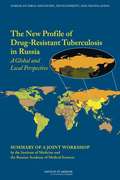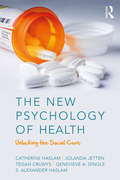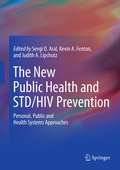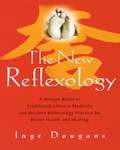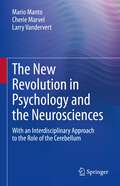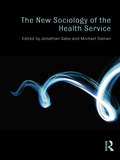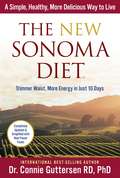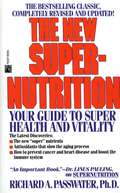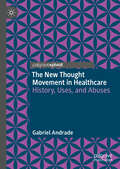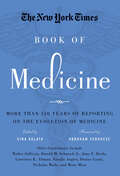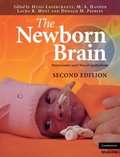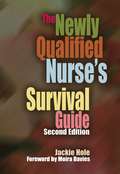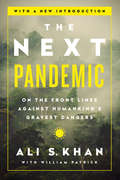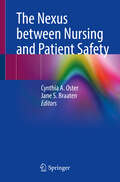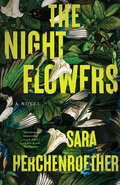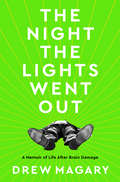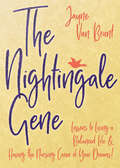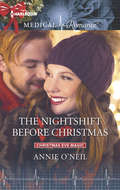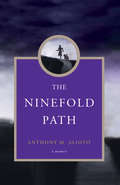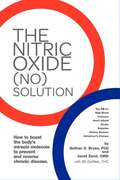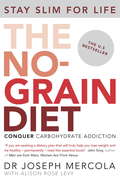- Table View
- List View
The New Profile of Drug-Resistant Tuberculosis in Russia: A Global and Local Perspective
by The National Academy of SciencesAn estimated 2 billion people, one third of the global population, are infected with Mycobacterium tuberculosis, the bacterium that causes tuberculosis. Spread through the air, this infectious disease killed 1. 7 million in 2009, and is the leading killer of people with HIV. Tuberculosis (TB) is also a disease of poverty--the vast majority of tuberculosis deaths occur in the developing world. Exacerbating the devastation caused by TB is the growing threat of drug-resistant forms of the disease in many parts of the world. Drug-resistant tuberculosis presents a number of significant challenges in terms of controlling its spread, diagnosing patients quickly and accurately, and using drugs to treat patients effectively. In Russia in recent decades, the rise of these strains of TB, resistant to standard antibiotic treatment, has been exacerbated by the occurrence of social, political, and economic upheavals. The Institute of Medicine (IOM) Forum on Drug Discovery, Development, and Translation, in conjunction with the Russian Academy of Medical Sciences held a workshop to discuss ways to fight the growing threat of drug-resistant TB. The New Profile of Drug-Resistant Tuberculosis in Russia: A Global and Local Perspective: Summary of a Joint Workshoppresents information from experts on the nature of this threat and how it can be addressed by exploring various treatment and diagnostic options.
The New Psychology of Health: Unlocking the Social Cure
by Jolanda Jetten Alex Haslam Catherine Haslam Tegan Cruwys Genevieve DingleWhy do people who are more socially connected live longer and have better health than those who are socially isolated? Why are social ties at least as good for your health as not smoking, having a good diet, and taking regular exercise? Why is treatment more effective when there is an alliance between therapist and client? Until now, researchers and practitioners have lacked a strong theoretical foundation for answering such questions. This ground-breaking book fills this gap by showing how social identity processes are key to understanding and effectively managing a broad range of health-related problems. Integrating a wealth of evidence that the authors and colleagues around the world have built up over the last decade, The New Psychology of Health provides a powerful framework for reconceptualising the psychological dimensions of a range of conditions – including stress, trauma, ageing, depression, addiction, eating behaviour, brain injury, and pain. Alongside reviews of current approaches to these various issues, each chapter provides an in-depth analysis of the ways in which theory and practice can be enriched by attention to social identity processes. Here the authors show not only how an array of social and structural factors shape health outcomes through their impact on group life, but also how this analysis can be harnessed to promote the delivery of ‘social cures’ in a range of fields. This is a must-have volume for service providers, practitioners, students, and researchers working in a wide range of disciplines and fields, and will also be essential reading for anyone whose goal it is to improve the health and well-being of people and communities in their care.
The New Public Health and STD/HIV Prevention
by Judith A. Lipshutz Kevin A. Fenton Sevgi O. AralDespite effective approaches to prevention, STD and HIV infection rates remain fairly constant. Targeting, implementation, and monitoring of interventions have posed widespread problems, and the recent spate of cuts to prevention budgets has made these roadblocks even more challenging. It is clear that working in sexual health requires both a deeper understanding of STI/HIV epidemiology and an ongoing quest for up-to-date, realistic prevention strategies. The New Public Health and STD/HIV Prevention offers readers leading-edge access to both. Focusing on social determinants of sexual health, at-risk populations, critical factors in approaches to prevention, and reviews of new research, this authoritative volume explores areas as varied as HPV prevention, technology-based interventions, migration as a factor in disease transmission, and competencies key to effective leadership in the field. Dispatches from the frontlines of theory, research, and practice in the U.S. and abroad include: Personal risk, public impact: balancing individual rights and STD/HIV prevention. Distribution of prevention resources and its impact on sexual health. Prevention measures in diverse populations of women. Toward a better approach to preventive interventions with men who have sex with men. Adolescent sexual health and STIs. Reducing disparities in sexual health: lessons from the campaign to eliminate infectious syphilis. Public health professionals of all backgrounds interested in or working in improving sexual health will find The New Public Health and STD/HIV Prevention an indispensable guide to conceptualizing the problems and clarifying possible solutions.
The New Reflexology: A Unique Blend of Traditional Chinese Medicine and Western Reflexology Practice for Better Health and Healing
by Inge DougansReflexology has always been an effective way to relieve stress, alleviate pain, and combat ailments, but in The New Reflexology, internationally acclaimed instructor Inge Dougans shows readers a unique and proven method for getting even better results. Her system - an integration of traditional Chinese medicine (particularly the 5 elements and their 12 meridians), diet, and standard Western reflexology practice - allows practitioners to treat a much wider variety of ailments with greater accuracy and success. In simple and straightforward terms, Dougans explains why the meridians are essential for reflexology, how to use meridian therapy and the 5 elements for effective assessment and treatment, how to relate structural foot problems to imbalances in the rest of the body, and much more. Illustrated with dozens of line drawings that guide readers step-by-step through the treatments, this fresh and highly effective approach is sure to revolutionize the practice of reflexology as we know it.
The New Revolution in Psychology and the Neurosciences: With an Interdisciplinary Approach to the Role of the Cerebellum
by Mario Manto Cherie Marvel Larry VandervertHistorically researchers of neuroscience and psychology have believed that the cerebral cortex produces the unique mental capacities of human beings. However, a prevalence of brain-imaging evidence now shows that the cerebral cortex, while the seat of our everyday experience (notably in working memory), is not predominant in actually formulating our amazing capabilities. Rather, the achievements that mark humans as “Homo sapiens” originate in the cerebellum which increased three- to fourfold in size and acquired massive cognitive and social optimization capabilities over the last million years. Thus, through its optimization of experience and skill of the cerebral cortex, it was the cerebellum that was and is predominant in producing culture, language, mathematics, creativity, and extreme levels of skill in all areas from sports to computer science and art. These optimizing functions of the cerebellum are shown in the cases of Albert Einstein, Wolfgang Amadeus Mozart, Maryam Mirzakhani, and the predictive powers of Stonehenge. This book fills a critical role in bringing courses up-to-date with the profound, basic changes this newly understood predominant role of the cerebellum provides for understanding the mechanisms related to all topics in psychology and neuroscience. It is critical that this “new revolution in psychology and the neurosciences” be introduced and reviewed in courses that are part of both undergraduate and graduate studies in psychology and neuroscience. This text might also be of use to courses in anthropology and cross-disciplinary studies as the cerebellum was critically involved in the evolution of cognitive and social behaviour.
The New Science of Overcoming Arthritis: Prevent or Reverse Your Pain, Discomfort, and Limitations
by Greg Ptacek Thomas VangsnessBattle the growing arthritis epidemic by taking steps now. Arthritis is truly an epidemic: more than 40 million Americans currently have arthritis, it is the leading cause of disability among people age 65 and older, and the overall annual costs to society are figured to be more than $65 billion. While it is present in nearly everyone by age 70, the problem is growing as arthritis more commonly appears in people as young as their 30s. But there is good news-while you can't cure arthritis, you can stave it off or manage it and dramatically improve your life. The New Science of Overcoming Arthritis offers a plan for anyone who wants to prevent or reverse their pain, discomfort, and limitations. It is the first book on arthritis that incorporates the latest research and treatment strategies for a disease that the vast majority of baby boomers will inevitably have to learn to live with. What's more, it provides younger generations with an easy-to-follow game plan for minimizing and even avoiding the more debilitating aspects of arthritis. It answers the most pressing questions, including: Why do we get arthritis? Which arthritis supplements are worthwhile? What are the best arthritis exercise and diet strategies? Which alternative therapies are sensible and safe? What is the latest science about stem cells and future therapies involving our genes and biology? Dr. Vangsness, a seasoned surgeon and team physician for USC Athletics, specializes in sports injuries and is a medical advisor on the cutting edge of arthritis research. He provides practical advice culled from his years working with star collegiate athletes, who are often on the front line in uncovering the best practices for dealing with injuries and the deterioration of the body's joints. While genetics play a large role in determining who will suffer from arthritis, and even how severely, there are strategies for staying active, pain-free, and healthy no matter who you are.
The New Sociology of the Health Service
by Jonathan Gabe Michael CalnanHealth service policy and health policy have changed considerably over the past fifteen years and there is a pressing need for an up-to-date sociological analysis of health policy. Not only have policies themselves changed but new policy themes – such as evidence-based policy and practice, an increasing focus on a primary care led health service, a growing recognition of the need to address inequalities through public health policies and a focus on the views and the voice of the user and the public– have emerged alongside some of the old. Following up the very successful The Sociology of the Health Service, this all-new volume covers a broad range of key contemporary health services issues. It includes chapters on consumerism, technology, evidence-based practice, public health, managerialism and social care among others, and incorporates references to new developments, such as regulation and incentivization, throughout. The New Sociology of the Health Service provides a vital new sociological framework for analyzing health policy and healthcare. It is an important read for all students and researchers of medical sociology and health policy.
The New Sonoma Diet
by Connie GuttersenLose weight, feel better, and enjoy your meals more than you ever thought with this brand new, updated version of the groundbreaking Sonoma plan for easy weight loss and healthy living.
The New Super-Nutrition
by Richard PasswaterFrom the renowned biochemist who created a health revolution with his bestselling Supernutrition in 1975 comes The New Supernutrition. Totally revised and updated, The New Supernutrition focuses on the latest scientific discoveries and offers solutions to the nutrition problems of the nineties. Richard A. Passwater, PhD, is internatinally acclaimed as a leader in research on megavitamins, trace minerals, and other nutrients. In this life-enhancing, health-saving guide, he offers a program of supernutrition talored to your specific needs that can do many things.
The New Thought Movement in Healthcare: History, Uses, and Abuses
by Gabriel AndradeThis book delves into the evolution of the New Thought Movement and its pervasive influence on modern healthcare. The book begins by tracing the roots of the New Thought Movement, originating in the 19th century, emphasizing the power of the mind in healing and personal development. Over time, this philosophy morphed into the contemporary positive thinking industry, becoming a significant component of Western self-help culture. The book explores how these ideas have become a contentious point in today's culture wars, polarized between supporters who credit it for personal empowerment and critics who highlight its limitations and potential harm. Central to the discussion is an in-depth analysis of the New Thought philosophy's impact on the healthcare industry. While acknowledging the potential benefits, such as motivating patients to adopt healthier lifestyles and fostering a sense of personal agency, the book critically examines how this philosophy's emphasis on mental positivity can lead to victim-blaming. It argues that oversimplifying health issues by attributing them solely to personal mindset obscures the multifaceted reality of health, particularly the significant role of social determinants of health and systemic inequities. This critique underscores how attributing illness to insufficient positive thinking can perpetuate stigma and neglect the socio-economic and environmental factors critical for understanding and addressing health challenges. By offering a nuanced perspective, the book aims to catalyze discussions on integrating mindful optimism with a holistic acknowledgment of the complexities inherent in healthcare, striving for a more balanced and equitable approach
The New York Times Book of Medicine: More than 150 Years of Reporting on the Evolution of Medicine
by Gina KolataToday we live longer, healthier lives than ever before in history—a transformation due almost entirely to tremendous advances in medicine. This change is so profound, with many major illnesses nearly wiped out, that its hard now to imagine what the world was like in 1851, when the New York Times began publishing. Treatments for depression, blood pressure, heart disease, ulcers, and diabetes came later; antibiotics were nonexistent, viruses unheard of, and no one realized yet that DNA carried blueprints for life or the importance of stem cells. Edited by award-winning writer Gina Kolata, this eye-opening collection of 150 articles from the New York Times archive charts the developing scientific insights and breakthroughs into diagnosing and treating conditions like typhoid, tuberculosis, cancer, diabetes, Alzheimers, and AIDS, and chronicles the struggles to treat mental illness and the enormous success of vaccines. It also reveals medical mistakes, lapses in ethics, and wrong paths taken in hopes of curing disease. Every illness, every landmark has a tale, and the newspapers top reporters tell each one with perceptiveness and skill.
The Newborn Brain
by Hugo Lagercrantz Laura R. Ment Donald M. Peebles M. A. HansonDevelopment of the brain and the emergence of the mind constitute some of the most important concerns of contemporary biology. Disturbances during fetal life may have profound implications for a child's future neurological and psychological development, which can in turn impact society. The new edition of this highly respected work presents a comprehensive review of the basic mechanisms of brain development and the pathophysiology of disorders of the infant brain, written by a team of distinguished neuroscientists, neonatologists, and neuropediatricians. The book follows the main milestones of brain development, from formation of the neural tube and wiring of the neurons in the brain. Neurotrophic factors, neurotransmitters, glial cell biology, cerebral circulation development of sensory functions are all described in detail. Furthermore, there are more philosophical chapters on the evolution of the brain and the emergence of consciousness. Clinical considerations are highlighted where relevant.
The Newly Qualified Nurse's Survival Guide (Radcliffe Ser.)
by Jackie HoleEven after years of training and hard work, finding yourself on the threshold of your nursing career is often a daunting prospect. In this revised and updated second edition, Jackie Hole provides clear, practical advice on both managing the transition from student to qualified nurse - including getting the most from your final placement and making applications - and practical advice on key areas encountered in the first weeks and months after qualification. Drug safety, dealing with common clinical problems, and how and when to seek expert advice are all covered, while a newly written chapter addresses the key area of infection control. Management aspects such as delegation, objective setting, budgeting, prioritisation of care and time management are outlined clearly and engagingly, along with questions of professional development and career futures. This book will be invaluable to newly-qualified nurses, as well as to student nurses, nurse tutors, and experienced nurses wishing to gain an insight into their own practice and changes in the profession.
The Next 500 Years: Engineering Life to Reach New Worlds
by Christopher E. MasonAn argument that we have a moral duty to colonize other planets and solar systems, and a plan for doing so.Inevitably, life on Earth will come to an end, whether by climate disaster, or by cataclysmic war, or when the sun runs out of fuel in a few billion years. To avoid extinction, will we have to find a new home planet, perhaps even a new solar system, to inhabit? In this provocative and fascinating book, Christopher Mason argues that we have a moral duty to do just that. Because we are the only species aware that life on Earth has an expiration date, we have a responsibility to act as the shepherd of lifeforms--not only for our species but for all species on which we depend and for those still to come (by accidental or designed evolution). Mason argues that the same capacity for ingenuity that has enabled us to build rockets and land on other planets can be applied to redesigning biology so that we can sustainably inhabit those planets. And he lays out a 500-year plan for undertaking the massively ambitious project of reengineering human genetics for life in other worlds.
The Next Generation of AIDS Patients: Service Needs and Vulnerabilities
by George J Huba Vivian BrownGo beyond traditional medical care to treat the whole person!In the past ten years, the treatment and epidemiology of AIDS have changed, and HIV/AIDS services must also change. The Next Generation of AIDS Patients suggests new ways to find and care for persons living with AIDS, not just by offering traditional medical treatment but by delivering needed support services as well. This landmark book defines the startling shift in demographics of this phase of the epidemic. The new AIDS patients have different problems than the white gay men who were strongly affected in the early days of the disease: some are substance abusers or sex workers or their partners, and many have children. Clients who are homeless, poorly educated, not native English speakers, or uninsured have overwhelming social support needs and need extra help to obtain their medical requirements. The Next Generation of AIDS Patients offers detailed analyses to help you determine clients’needs and vulnerability levels, so you can provide complete biopsychosocial services. In addition, the original empirical research in this book reveals which programs deliver the best outcomes for various client populations. The Next Generation of AIDS Patientssupplies you with an effective data modeling approach for determining levels of vulnerability and need, and discusses such vital issues as: identifying and overcoming barriers to HIV care engaging and retaining in care individuals with high levels of unmet need delivering services to diverse minority populations, substance abusers, homeless people, and those who live in rural areas client satisfaction in community service organizationsIn order to develop successful community-based health care and support services, medical and social work professionals must take the new face of this disease into account. The Next Generation of AIDS Patients offers practical advice, readily applicable theory, and proven strategies for caring for people living with AIDS.
The Next Pandemic: On the Front Lines Against Humankind's Gravest Dangers
by William Patrick Ali KhanDuring the 2014 Ebola crisis, the public watched with rapt attention as a handful of Americans contracted the deadly fever and were transported to treatment facilities in the United States. We charted the movements of Dr. Craig Spencer, whose three-mile jog and subway ride to a bowling alley became national news, fearing for our lives. Yet the panic far outstripped the reality of the situation; Dr. Spencer survived, and the disease spread no further. The American Ebola outbreak began and ended with two fatalities.To Dr. Ali Khan, the 2014 Ebola scare was simply another example of public paranoia about infectious disease; he has been on the front lines of each one - and many we didn't hear about- over the last 25 years. During the 1995 Ebola outbreak in Zaire, Khan found patient zero; he traveled to Washington, DC, in 2001 as a first responder in the anthrax crisis; and went to southeast Asia to treat patients of SARS. The University of Nebraska Medical Center, where Khan is now Dean of Public Health, is one of four biohazard containment units in the United States; four Ebola patients were treated there in 2014.In this riveting book, Khan tells the dramatic stories of these crises-as well as the stories we don't know-of congo-crimean hemorrhagic fever infecting abattoirs in the United Arab Emirates, as cigarette-smoking local doctors rushed to the scene, for instance; or of being shot at by militias in the African bush while trying to treat monkeypox.The book's message is every bit as urgent as his stories: we are focused on the wrong problems. Khan reminds us that the danger of an outbreak-more real than ever in the age of climate change and global travel-is not a matter of which disease is the most deadly or violent. Instead, he urges readers to spread good information and practice essential habits.Untitled CDC Memoir is a vivid and necessary book about rampant and violent diseases, and disasters narrowly averted- and the tools we need to keep them at bay.
The Nexus between Nursing and Patient Safety
by Cynthia A. Oster Jane S. BraatenThe aim of this unique book is to discuss the “nexus” or vital connection between nursing and prevention of harm to patients. The meaning of “nexus” is connection and connotes a most central or most important point in time or place. Now, is the most important time to highlight how nurses as leaders affect patient safety every minute of every day in the current nursing practice environment. The contemporary safety literature messages nursing adherence to principles of patient safety is required to achieve sustainable and safer healthcare systems; meaning nurses should detect and prevent errors. This message is not helpful to nurses as they strive to lead, understand what patient safety is and how to implement safety strategies in the practice environment. The book will address this gap by providing nurses an understanding of patient safety and application of its concepts to clinical nursing practice. The book is structured as four parts: Part I provides foundations of patient safety; Part II describes nursing’s role in patient safety; Part III illustrates patient safety at the frontline; and Part IV explains resilience, healing and moving forward. Practical case study examples with implementation strategies (how to) will be provided that highlight key safety practices inherent to nursing that prevent patient harm including effective monitoring, leadership, communication, identification of near misses, and learning from error along with cultural and organizational factors that promote and maintain safety activities by nursing.Nurses produce safety by providing a strong layer of defence between error and patient harm. The discipline of nursing is the cornerstone of safety in the complex place of healthcare. The intended audience is front line nursing staff; nurse leaders; nurses working in quality, patient safety and risk management; advance practice nurses and nurse educators. The professional nurse who reads this book will read with the desire to learn more about the connection of nursing, nursing practice and patient safety.
The Nigerian Healthcare System: Pathway to Universal and High-Quality Health Care
by Joseph Abiodun BalogunThe modern-day practice of health care was imported into Nigeria over 500 years ago. In 1947, the first national health plan was developed in Nigeria with the primary goal of providing universal health care (UHC), but this goal remains elusive to date. This comprehensive book presents the roadmap needed to attain UHC in Nigeria and offers a blueprint for achieving high-quality health care in the nation.Starting with a brief overview of the Nigerian state, the fundamentals of health care, including the challenges to affordable quality healthcare delivery, the author critically examines the healthcare system in Nigeria and offers specific recommendations to invigorate the system and improve interprofessional collaborations. Each chapter includes case studies to allow readers to contextualize the information presented and behavioral learning objectives to test readers' knowledge. Among the topics covered:The Organizational Structure and Leadership of the Nigerian Healthcare SystemThe Vulnerabilities of the Nigerian Healthcare SystemThe Spectrum of Complementary and Alternative MedicineEmerging Developments in Traditional Medicine Practice in Nigeria The Plight of Persons Living with Disabilities: The Visible Invisibles in NigeriaA Comparative Analysis of the Health System of Nigeria and Six Selected Nations Around the WorldA Qualitative Investigation of the Barriers to the Delivery of High-Quality Healthcare Services in NigeriaThe Political and Economic Reforms Needed to Achieve Universal and High-Quality Health Care in NigeriaReimagining the Nigerian Healthcare System to Achieve Universal and High-Quality Health Care by 2030The Nigerian Healthcare System: Pathway to Universal and High-Quality Health Care is ideal for adoption as a textbook in health services administration, health policy and management, health informatics, healthcare delivery systems, and primary health care courses offered at universities in Nigeria. It also would appeal to students and faculty in African diaspora programs internationally. The book is also essential for policymakers, health systems technocrats, researchers, and professionals in various health disciplines, including medicine, nursing, and allied health.
The Night Flowers
by Sara HerchenroetherPeople tend to think of us as shadows. Blurred black mist. Often, it’s “out of the corner of my eye.” People sense the cold. I’ve heard of ghost hunters who use a tape measure, laying it on the ground to mark our boundaries. I don’t want to be measured. In 1983, deep in New Mexico’s Gila National Forest, the bodies of a young woman and two children were found. Who were they? How did they get there? Thirty years later, two women find themselves drawn to the cold case. Librarian Laura MacDonald begins her own investigation as a way to distract herself from breast cancer treatments and becomes consumed by her search for answers. Jean Martinez is a veteran detective determined to keep working cold cases for the Sierra County police force even as her family begs her to retire. With only fragments from dusty case files and a witness who doesn’t want to remember, this unlikely duo is determined—no matter the cost—to uncover the truth behind the murders. And with their help, the woman in the woods is finally able to tell her story on her own terms and summon the power to be found. The Night Flowers—a haunting debut thriller written with pulse-pounding precision and a deep understanding of the psychology of violence and the tenacity of those who combat it—announces the arrival of Sara Herchenroether as an exciting new voice.
The Night the Lights Went Out: A Memoir of Life After Brain Damage
by Drew MagaryA fascinating, darkly funny comeback story of learning to live with a broken mind after a near-fatal traumatic brain injury—from the acclaimed author of The Hike&“Drew Magary has produced a remarkable account of his journey, one that is filled with terror, tenderness, beauty, and grace.&”—David Grann, bestselling author of Killers of the Flower Moon Drew Magary, fan-favorite Defector and former Deadspin columnist, is known for his acerbic takes and his surprisingly nuanced chronicling of his own life. But in The Night the Lights Went Out, he finds himself far out of his depths. On the night of the 2018 Deadspin Awards, he suffered a mysterious fall that caused him to smash his head so hard on a cement floor that he cracked his skull in three places and suffered a catastrophic brain hemorrhage. For two weeks, he remained in a coma. The world was gone to him, and him to it. In his long recovery from his injury, including understanding what his family and friends went through as he lay there dying, coming to terms with his now permanent disabilities, and trying to find some lesson in this cosmic accident, he leaned on the one sure thing that he knows and that didn't leave him—his writing.Drew takes a deep dive into what it meant to be a bystander to his own death and figuring out who this new Drew is: a Drew that doesn't walk as well, doesn't taste or smell or see or hear as well, and a Drew that is often failing as a husband and a father as he bounces between grumpiness, irritability, and existential fury. But what's a good comeback story without heartbreak? Eager to get back what he lost, Drew experiences an awakening of a whole other kind in this incredibly funny, medically illuminating, and heartfelt memoir.
The Nightingale Gene: Lessons to Living a Balanced Life & Having the Nursing Career of Your Dreams
by Jayne Van BruntThe first in a trilogy highlighting caregiving as a demanding, yet rewarding, profession that forces work-life imbalance, The Nightingale Gene provides lessons for those who make caring for others a priority over taking care of themselves.By the year 2020, the United States will experience a shortage of more than 1 million nurses as baby boomers in the profession retire and hospitals struggle to keep up with supply and demand as the boomer-aging population stresses the already overtaxed staff. Nurses account for more than 75% of the employees in a hospital, but new nurses continue to seek other less stressful careers, remaining in their positions an average of only 6 months, citing poor management and burnout as reasons for leaving. The profession gives nurses both high reward and intense stress. The demand to find, train, and retain quality staff has never been more urgent than now.The Nightingale Gene provides nurses and healthcare leaders with lessons that address the obvious recruiting and retention demands they face today, focusing first on their own issues and then trickling down to staff. Jayne Van Brunt addresses why nurses and healthcare leaders are wired to hover over everyone else while ignoring their own desires, featuring themes of self-help, self-love, and forgiveness while presenting an easy formula to implement and intentional work-life plan to make nursing and other caregiving professions rewarding again. Written in lyrical fashion, The Nightingale Gene tells the story of one woman&’s transformational journey and the lessons she learned along her way back to living in balance.
The Nightshift Before Christmas (Christmas Eve Magic #2)
by Annie O'NeilAll through the hospital… magic was stirring It might be Christmas, but Dr. Katie McGann would prefer to bury her head in her work than celebrate. Until her estranged husband Dr. Josh West strides into the ER, turning heads and making her heart flip. Two years ago their world and their dreams ended, and they had to part. But Josh vowed never to stop fighting for his wife, and with the clock about to strike midnight he knows he has one last chance to heal Katie&’s heart…one kiss under the mistletoe at a time. Christmas Eve Magic Reunited on the night before Christmas!
The Ninefold Path
by Anthony M. AliotoAnthony Alioto was diagnosed with end stage renal disease in 1993 and was forced to go on dialysis for several years before receiving a successful kidney transplant in 2000. "In The Ninefold Path," he invites readers to join him on a harrowing personal journey through a labyrinth of tests, OC what can I expectOCO meetings with medical staff, surgeries, and near-death experiences. He spares no detail in his desire to provide a guide for others living with a chronic disease OCo and their families and friends OCo on how to navigate the oftentimes rough waters of modern medicine. "The Ninefold Path" is for all of those wearily traveling through chronic illnesses and for those by their sides wondering what to do, it is a celebration of the extraordinary individuals in medicine who relieve the suffering of strangers each and every day. In cataloging detail, there is inspiration, plus a call to compassion and serenity. A Note to the Reader from "The Ninefold Path": OC The reader can expect to encounter a very personal and human account of chronic illness, sometimes painful, sometimes hilarious, and then at times simply absurd OCo but, hopefully, also moving. One need not search for profound insights, recipes, therapy, or sage advice. It is my hope that you will come away with a feeling, a sense of being there, maybe a kind of liberation from the OCymerely personalOCO as Einstein phrased it, and a new appreciation for what others endure daily. Even in the midst of suffering physical pain and mental anguish, a person may yet gain the freedom to live a life of celebration, joy, compassion, and serenity. Zen Master Kyong Ho once said, OCyDonOCOt hope for life without problems. An easy life results in a judgmental and lazy mind. OCOOCO"
The Nitric Oxide Solution
by Bill Gottlieb Nathan Bryan Janet ZandEighty-one million Americans have cardiovascular disease, the arterial damage that leads to the heart attacks and strokes that account for 36 percent of all deaths in the U.S. But few people know that by boosting the body’s levels of a single molecule―nitric oxide (NO)―you can help prevent, control and even reverse cardiovascular disease. <p><p>In this groundbreaking book, nitric oxide expert Nathan Bryan, PhD, and natural healer Janet Zand, OMD, tell you all about nitric oxide, the “miracle molecule” that can dramatically improve your health. What the molecule is. How it keeps your arteries young and flexible, regulating blood pressure, and stopping the buildup of artery-clogging plaque. Why most people over 40-years-old have severely diminished levels of NO, and what to do about it. They also show how the molecule works to prevent and treat other chronic conditions, such as diabetes, arthritis, asthma, osteoporosis, and erectile dysfunction. And how it strengthens the immune system and energizes the brain. <p><p> The book includes dozens of easy-to-follow tips for increasing NO levels, using NO-boosting foods, supplements, easy exercise, and other natural methods like deep breathing, naps, hot baths, acupuncture―even watching movies that make you laugh! <p><p> The Nitric Oxide (NO) Solution provides you with the best and simplest solution to the problems of cardiovascular disease, aging, and ill health. <p><p> About The Authors Nathan Bryan, PhD is a leading expert on nitric oxide, and assistant professor of molecular medicine at the Brown Foundation Institute of Molecular Medicine of the School of Medicine at the University of Texas Health Science Center in Houston. Janet Zand, OMD, is a doctor of oriental medicine, author of several books on natural healing, and a pioneer in the development of nutritional and herbal supplements. Bill Gottlieb is an author specializing in natural health whose books have sold more than 2 million copies.
The No-Grain Diet
by Dr Joseph MercolaForget fats as the biggest dietary sin, the latest scientific evidence now shows that the real culprits in escalating weight gain are grains, starches and sugars. By eliminating grains from your diet, you actually reprogramme your mind and body to release fat and burn it, and as a result the weight you lose is kept off - permanently. This all-new low carbohydrate diet moves on from Dr Atkins, cutting out the unhealthy side-effects of that diet and including a wider range of healthy foods than Atkins or any of his successors.The No Grain diet offers three plans tailored to suit your needs: The booster plan (to ease you more gently into the plan), the core plan (for faster results), and the advanced plan (for those who need to lose a lot of weight fast for health reasons). What's more, it presents a unique psychological technique to combat cravings, bolster your self-belief and help you ride low periods, which usually lead you to break the diet. With delicious recipes and advice on additional factors to further support your new healthy lifestyle, The No Grain Diet is the last diet book you'll ever need.
